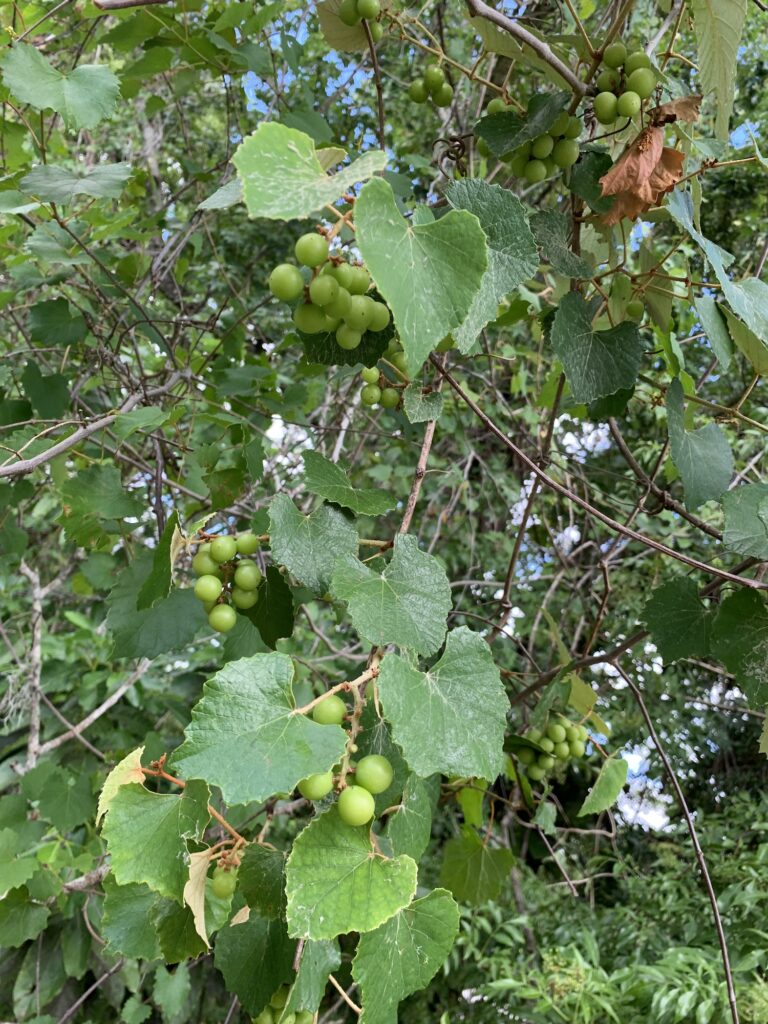
Forked-tendril grapes putting on fruit in Melbourne. Photo by Green Deane
An age-old mystery is why some plants do better in different years. Clouds, rain, temperatures, soil condition, timing can all affect plants particularly grapes. It looks like it will be a good year for grapes locally. They have been fruiting heavily, not only the reliable forked tendril grapes but the iffy single tendrils as well. They ripen locally about September (when I grew up in Maine, it was September as well, I would scrump grapes walking home from school.) They can ripen as early as late July or as late as mid-October.
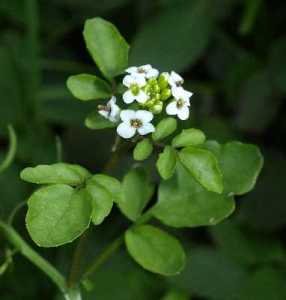
Watercress in blossom. Photo by Green Deane
May is indeed a warm-weather month locally but we managed to find a cold-loving plant last weekend in a ditch in Melbourne: Watercress. It was nearing its seasonal end by putting on seeds, but still edible (cooked. The species can be eaten raw if grown in wholesome water, but in ditches one chances parasites from animal dropping, so cooking is wise.) It’s in the greater mustard family, as noted by the four-petal blossom. Sanford, Florida used to be the winter watercress capitol of the world but like some of the space industry it was moved to Huntsville, Alabama.
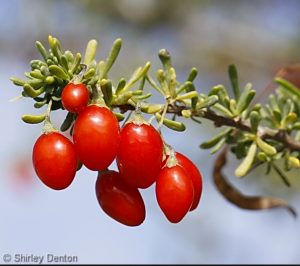
Goji berries are slightly sweet. Photo by Green Deane
Foraging folks are often surprised to learn Goji berries grow in North America and are native. A popular supplement it grows in China and was introduced to southern Britain. We find them locally in brackish water areas, and are common south of Daytona Beach on the inland waterway. It’s a very scraggly shrub usually ladened with Ramalina lichen which tends to give it a dead appearance as the leaves are small. The jelly-bean like red fruit is related to the tomatoes as the species is in the nightshade family.
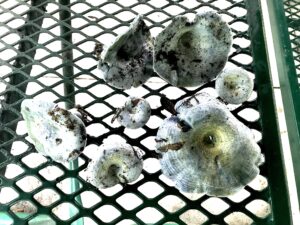
Edible Indigo milk caps, photo by Green Deane
Two years ago at this time, the wild mushroom season was well underway, we had a foraging class with Joshua Buchanan in Seminole County and collected five different species of edible mushrooms. One needs warm ground and a lot of rain for the season to start. We usually get 10 days to two weeks of rain in May or June to kick the season into high gear. I checked my favorite mushrooming location and saw none last weekend. As much rain is forecast this month perhaps we’ll be harvesting fungi soon.

Classes are held rain or shine (but not during hurricanes.)
Foraging Classes: We may have to dodge rain showers this weekend during classes.
June 3rd, Eagle Lake, 1800 Keene Road, Largo, FL 33771. Meet at the pavilion near the dog park, 9 a.m.
June 4th, Mead Gaden, 1500 S. Denning Dr., Winter Park, FL 32789. Meet at the bathrooms. 9 a.m.
June 10, Colby-Alderman Park: 1099 Massachusetts Street, Cassadaga. Fla. 9 a.m., meet at the bathrooms.
June 11, Red Bug Slough 5200 S. Beneva Road, Sarasota. 9 a.m.
Bring cash on the day of class or click here to pay for your class
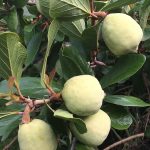
Is it time to take the Creeping Fig out of the edible realm? Photo by Green Deane
What is it? The answer is barely edible. Many years ago while sipping a beer at an outside bar in Ybor City I saw a prolific vine on a brick wall with what looked like a large green fig. I was reasonably sure it wasn’t a product of the beer so some research was in order. It was a Creepin Fig. The main problem with the species — besides barely making it into the edible realm — is growth pattern. The leaves and vines of the fig when young are very small then at some point the plant transforms itself into a large vine with leaves having little resemblance to what it used to be. Then it produces green fig-like fruit. The fruit basically is not edible. But the expressed juice jelled in water is. That’s a bit strange. To read about it, go here.

You get the USB, not the key.
My nine-DVD set of 135 videos has been phased out and replaced by 171-videos on a 128-GB USB, see right. The USB videos are the same videos I have on You Tube. Some people like to have their own copy especially if social order falters. The USB videos have to be copied to your computer to play. If you want to order the USB go to the DVD/USB order button on the top right of this page or click here. That will take you to an order form. Or you can make a $99 donation, which tells me it is for the USB (include a snail-mail address.) I’d like to thank all of you who ordered the DVD set over the years which required me to burn over 5,000 DVDs individually. I had to stop making them as few programs now will read the ISO files to copy them. Burning a set also took about three hours.

Green Deane Forum
Want to identify a plant? Perhaps you’re looking for a foraging reference? You might have a UFO, an Unidentified Flowering Object, you want identified. On the Green Deane Forum we — including Green Deane and others from around the world — chat about foraging all year. And it’s not just about warm-weather plants or just North American flora. Many nations share common weeds so there’s a lot to talk about. There’s also more than weeds. The reference section has information for foraging around the world. There are also articles on food preservation, and forgotten skills from making bows to fermenting food. Recent topics include: Stale Bread and Cod Liver Oil, Killing Bugs with Tobacco Plugs, Eating weeds: Is it safe? Have they mutated? Not the Eastern Red Bug but the Pink Tabebuia, African Tulip Tree, Asparagus densiflorus, Green Deane’s Book… You can join the forum by clicking on the button on the upper right hand side of this page.
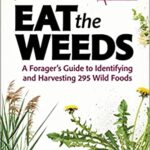
EatTheWeeds by Green Deane
For those of you who’ve been inquiring, the book EatTheWeeds, first volume, will be printed in October, it can be pre-ordered now on Amazon. It has about 300 plants, their nutritional information and my notes. Most of the hurdles and hoops required for publication have been met and all is good to go.
This is my weekly newsletter #560. If you want to subscribe to this free newsletter you can find the sign-up form in the menu at the top of the page. My website, EatTheWeeds.com, which is data secure, has over 1500 plants on it in some 428 articles. I wrote every one myself, no cut and paste.
To donate to the Green Deane Newsletter click here.

